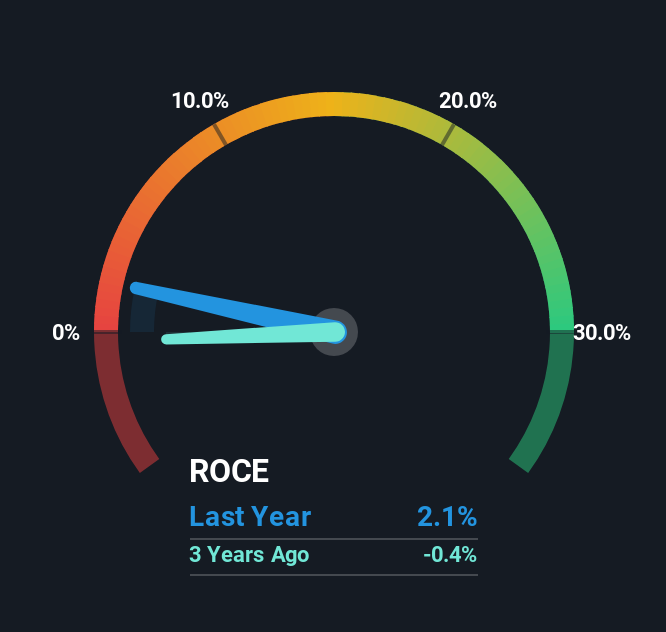The Return Trends At PGF Polska Grupa Fotowoltaiczna (WSE:PGV) Look Promising
If you're not sure where to start when looking for the next multi-bagger, there are a few key trends you should keep an eye out for. Firstly, we'll want to see a proven return on capital employed (ROCE) that is increasing, and secondly, an expanding base of capital employed. This shows us that it's a compounding machine, able to continually reinvest its earnings back into the business and generate higher returns. So when we looked at PGF Polska Grupa Fotowoltaiczna (WSE:PGV) and its trend of ROCE, we really liked what we saw.
Return On Capital Employed (ROCE): What Is It?
For those who don't know, ROCE is a measure of a company's yearly pre-tax profit (its return), relative to the capital employed in the business. Analysts use this formula to calculate it for PGF Polska Grupa Fotowoltaiczna:
Return on Capital Employed = Earnings Before Interest and Tax (EBIT) ÷ (Total Assets - Current Liabilities)
0.021 = zł2.2m ÷ (zł125m - zł21m) (Based on the trailing twelve months to December 2024).
So, PGF Polska Grupa Fotowoltaiczna has an ROCE of 2.1%. Ultimately, that's a low return and it under-performs the Machinery industry average of 7.6%.
Check out our latest analysis for PGF Polska Grupa Fotowoltaiczna

Historical performance is a great place to start when researching a stock so above you can see the gauge for PGF Polska Grupa Fotowoltaiczna's ROCE against it's prior returns. If you want to delve into the historical earnings , check out these free graphs detailing revenue and cash flow performance of PGF Polska Grupa Fotowoltaiczna.
So How Is PGF Polska Grupa Fotowoltaiczna's ROCE Trending?
Like most people, we're pleased that PGF Polska Grupa Fotowoltaiczna is now generating some pretax earnings. Historically the company was generating losses but as we can see from the latest figures referenced above, they're now earning 2.1% on their capital employed. At first glance, it seems the business is getting more proficient at generating returns, because over the same period, the amount of capital employed has reduced by 73%. The reduction could indicate that the company is selling some assets, and considering returns are up, they appear to be selling the right ones.
On a side note, we noticed that the improvement in ROCE appears to be partly fueled by an increase in current liabilities. Effectively this means that suppliers or short-term creditors are now funding 16% of the business, which is more than it was five years ago. Keep an eye out for future increases because when the ratio of current liabilities to total assets gets particularly high, this can introduce some new risks for the business.
The Key Takeaway
In the end, PGF Polska Grupa Fotowoltaiczna has proven it's capital allocation skills are good with those higher returns from less amount of capital. Given the stock has declined 15% in the last five years, this could be a good investment if the valuation and other metrics are also appealing. So researching this company further and determining whether or not these trends will continue seems justified.
One more thing: We've identified 3 warning signs with PGF Polska Grupa Fotowoltaiczna (at least 2 which are a bit concerning) , and understanding them would certainly be useful.
For those who like to invest in solid companies, check out this free list of companies with solid balance sheets and high returns on equity.
New: Manage All Your Stock Portfolios in One Place
We've created the ultimate portfolio companion for stock investors, and it's free.
• Connect an unlimited number of Portfolios and see your total in one currency
• Be alerted to new Warning Signs or Risks via email or mobile
• Track the Fair Value of your stocks
Have feedback on this article? Concerned about the content? Get in touch with us directly. Alternatively, email editorial-team (at) simplywallst.com.
This article by Simply Wall St is general in nature. We provide commentary based on historical data and analyst forecasts only using an unbiased methodology and our articles are not intended to be financial advice. It does not constitute a recommendation to buy or sell any stock, and does not take account of your objectives, or your financial situation. We aim to bring you long-term focused analysis driven by fundamental data. Note that our analysis may not factor in the latest price-sensitive company announcements or qualitative material. Simply Wall St has no position in any stocks mentioned.
About WSE:PGV
PGF Polska Grupa Fotowoltaiczna
An investment company, operates in the renewable energy sector primarily focusing on the photovoltaic market in Poland.
Mediocre balance sheet with low risk.
Market Insights
Community Narratives



